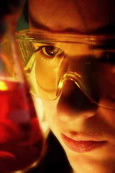Creating Safety Cultures in Academic Institutions
Robert H. Hill, Jr., Chair of the ACS Joint Board/Council Committee on Chemical Safety
Laboratory and chemical safety are primary concerns of our chemical enterprise. Laboratory incidents in the academic community within the recent past have drawn the attention and scrutiny of the public media, federal investigators, and public prosecutors—and these incidents and their impact have greatly concerned many in academia. This is particularly true of those in graduate programs, where individuals conduct independent research and the risks increase. Graduate students and postdocs have a special, dual interest in chemical safety. As scientists, you have the concern of guarding your own health and safety. As future faculty and administrators, you must prepare to protect the next generation of researchers who will be working under you. The newly created Safety Culture Task Force arose from a mission to create or reinforce an academic atmosphere in which safety takes the paramount role. The Elements of a Strong Safety Culture enumerated below will help you bring your interest in chemical and laboratory safety into everyday practice.
What Is the Safety Culture Task Force?
To assist in building and reinforcing strong safety cultures in academic institutions, the ACS Committee on Chemical Safety (CCS) formed the Safety Culture Task Force. Seeking to establish a broad collaboration, CCS created this taskforce with members from CCS, the Society Committee on Education, the Committee on Professional Training, the Division of Chemical Health and Safety, and the Younger Chemists Committee.
The Safety Culture Task Force identified elements of strong safety cultures (see below), topics and resources for laboratory and chemical safety education, and recommendations to build and enhance safety cultures in academic institutions.
The resulting report, Creating Safety Cultures in Academic Institutions, was approved by CCS at the 243rd ACS National Meeting in San Diego and is now available on the CCS website at www.acs.org/safety. The report was dedicated to those scientists who lost their lives or were injured in laboratory incidents.
Elements of Strong Safety Cultures
- 1: Leadership and management—Responsibilities and accountability for safety must be clearly defined from the highest levels of the administration, down through schools and departments, to individual faculty and staff. Leading by example is a requirement of all members of an institution, especially faculty.
- 2: Teaching laboratory and chemical safety—Every chemist needs an in-depth knowledge of laboratory and chemical safety. He or she should acquire this safety knowledge and education continually through years of educational process. The report suggests about 80 safety topics that should be taught, and it emphasizes teaching “critical thinking” skills in laboratory and chemical safety.
- 3: Strong safety attitudes, awareness, and ethics—Strong positive attitudes about safety require long-term efforts through continuous emphasis on safety. Teaching (and learning) safety is an ethical responsibility. The Safety Ethic reflects the proper attitude of valuing safety.
- 4: Learning from laboratory incidents—Studies of incidents capture interest and teach lessons about safety. Institutions should implement a system of reporting and investigating incidents.
- 5: Establishing collaborative relationships—Safety culture requires close, trusting collaborations among all members of the academic community—including faculty members; administrative staff; students; postdoctoral scholars; and Environmental, Health, and Safety staff—as well as public emergency responders.
- 6: Promoting and communicating safety—Demonstrating safety practices through personal example and recognizing positive safety behaviors are important ways to promote safety. Safety should be reinforced through continuous and diverse efforts.
- 7: Strong safety programs require funding—All strong safety programs require investment of substantial effort with adequate and continuous funding by institutional administrations. Identifying responsibilities for safety is a critical step in determining budgets.
Incorporating the Safety Culture into Your Academic Community
All of the elements listed above are essential and necessary in building strong safety cultures, but perhaps the most important concepts are leadership and safety education. As future faculty and staff, graduate students and postdocs should prepare to accept responsibility for safety and lead by example. This includes ensuring that undergraduates’, graduates’, and postdoctoral scholars’ curricula include comprehensive laboratory and chemical safety education. Those teaching and conducting research in laboratories should also receive an education in laboratory and chemical safety—and this includes the many in graduate programs who oversee and teach in undergraduate laboratories.
Additionally, the Creating Safety Cultures report lists 17 recommendations that serve as guidelines for building strong safety cultures. These recommendations were derived from the essential elements that are listed above. As academic institutions implement these measures, strong safety cultures should evolve that ensure safety is an integral part of all teaching and research programs.
Dr. Robert H. Hill, Jr., is the Chair of the ACS Joint Board/Council Committee on Chemical Safety. Dr. Hill is a Public Health Program Manager with Battelle in Atlanta, GA. Formerly he worked in or managed laboratories for 30 years, and he has more than 30 years of experience working in occupational and environmental health at the Centers for Disease Control and Prevention (CDC). He has served as Member-at-Large, Chair-Elect, Chair, and Immediate Past Chair in the ACS's Division of Chemical Health and Safety. He has served as a member of the Board of Editors of the Journal of Chemical Health and Safety since 2000. Dr. Hill received his Ph.D. in chemistry from the Georgia Institute of Technology (Georgia Tech) and his B.S. in chemistry from Georgia State University.
See “Lab Tales: How a Chemistry Experiment/Explosion Changed My Life” on the Chemistry Grad Student and Postdoc Blog




